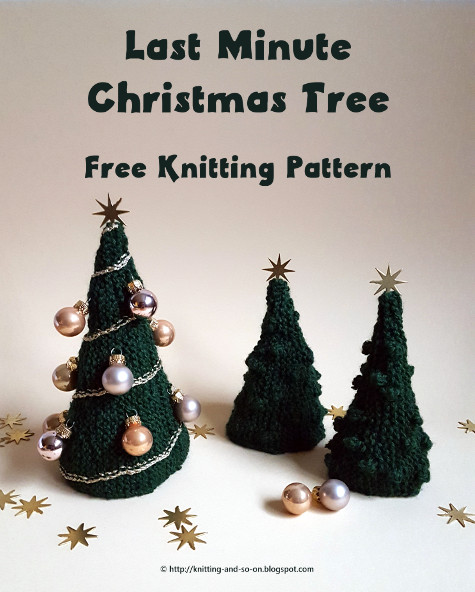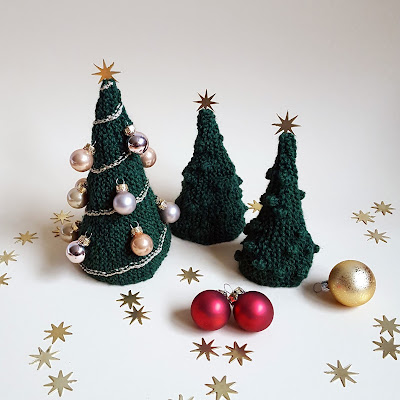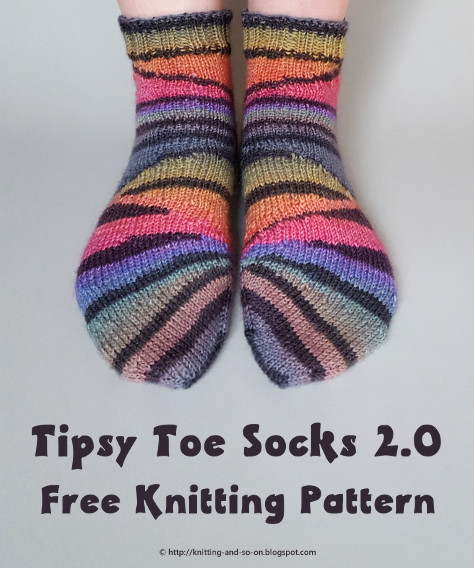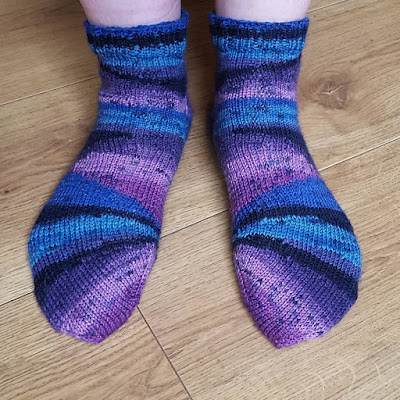For a KAL I wanted to knit another pair of socks - but something that wouldn't bore me and something that would bring out the colors of self-striping yarn. I had always thought that my
Tipsy Toe Socks were interesting at the start (the toes) but slightly boring for the rest of the pattern. That's why I wanted to continue a pattern of wedges for the whole sock. It took me a while to a) get it right and b)
choose the right yarn for the pattern. But now that they are finished I really like them.
These socks are knitted toe-up, but unlike the original
Tipsy Toe Sock pattern (where I used German short rows for the wedges, but not the heel) I used only Shadow wrap short rows here. For me these short rows looked neater than any other type that I had tried to knit in the round.

This work by
Knitting and so on is licensed under a
Creative Commons Attribution-NonCommercial-NoDerivatives 4.0 International License.
 Materials
Materials
- 50 to 80 grams of fingering weight yarn - depending on how long you like your sock cuff; for the rainbow colored ones I used Lang Yarns Twin Soxx (color 909, here's a link to the yarn's Ravelry page) and for the blue-purple one Vendita Sockenwolle (bought at Aldi's a few years ago - here's a link to the yarns Ravelry page).
- 2.5mm needles - I used Addi CrasyTrio, but you can use dpns or a circular needle (with Magic Loop method) as well
- 2.25mm needles - to knit the ribbing
- 2 different stitch markers - one to mark the end of round (called "end marker") and one to mark the middle of the round (called "middle marker")
- a tapestry needle to weave in ends
Techniques
- Judy's Magic Cast-On is a technique that gives you live stitches on both sides of your needle - it is generally used for toe-up socks (e.g. in this pattern), but it can be used for other purposes as well. Here's a written description (from Knitty) and here's a YouTube-video by Cat Bordhi and another YouTube-video by Very Pink Knits.
- Shadow Wrap Short Rows - used throughout the pattern: as shown in this YouTube video by Lee Meredith. A video by Miriam Felton that shows how to do a heel with shadow wraps can be found here on YouTube. However, the heel knitted here is knitted slightly different because here there are two rounds between the two parts of the heel, i.e. there won't be any triple stitches.
- Knitting the Shadow Wraps: In a knit row (i.e. you're knitting on the outside of your socks), you knit up to the stitch where you want to turn, and then knit into the stitch in the row below, i.e. you insert the right hand needle from the front into the stitch below the next stitch and pull your working yarn through. Then you put the loop onto the left hand needle (creating a double stitch from the stitch below) - keeping the yarn on the back. Then you turn and your yarn is now in front, tighten it to make sure that all stitches have the same size and start to purl in the opposite direction. This sequence (knitting int the stitch below and turning) will be called kbelow in the pattern.
If you're in a purl row, you purl into the stitch of the row below, i.e. insert the right hand needle from the back into the stitch below and draw your yarn through and put the stitch onto your left hand needle - creating a double stitch. The yarn is in front while you're doing this. Turn your work. The yarn is now on the back of your knitting. Make sure that the stitch is as tight as the other stitches on your needles and start knitting in the opposite direction. This sequence will be called pbelow in the pattern.
- Knitting the double stitch.: When you come to a double stitch you can simply knit / purl it as one. This looks well when you're working it in the same direction it was created (i.e. the double stitch was created in a purl row and is also worked in a purl row). However, when you have to knit a double stitch that was created in a purl row, the following sequence made the result look a bit neater. I slipped the first loop of the double stitch to the right hand needle, turned the second loop so that the front leg was now in the back and put the first loop back facing the same way (i.e. the former front leg was now in the back). Then I knitted both loops through the back loop.

Gauge and Sizes
When I knitted these 19 rows of stockinette gave 5cm in height and 16 sts (stockinette) gave 5 cm in width. But If you've knitted socks before, you'll know which total stitch count to aim for. Here's the table that shows you the usual amount of stitches you need for your shoe size. Furthermore, it shows over how many stitches you're going to knit the heel (after some increases) and how these stitches are distributed, i.e. how many stitches are used for short rows at each side.
E.g. for size 36 you work the heel over 34 stitches, i.e. you do short rows for 11 stitches on both sides and 12 stitches in the middle are knitted normally.
| shoe size | total number of stitches | heel stitches (after increasing) | distribution of heel stitches |
|---|
| 32-35 | 56 = 2x28 | 28 + 4 = 32 | 11 - 10 - 11 |
| 36-39 | 60 = 2x30 | 30 + 4 = 34 | 11 - 12 - 11 |
| 40-43 | 64 = 2x32 | 32 + 4 = 36 | 12 - 12 - 12 |
Instructions for sizes are given as follows: sizes 32-35 [sizes 36-39, sizes 40-43]. I.e. the instructions before the brackets are for sizes 32 to 35 and in brackets first for sizes 36 to 39 and then for sizes 40 to 43.
Instructions
First Sock
Toe
Do a magic CO of 2x10 sts [2x10, 2x12]
Round 1: k8 [k8, k10],
kfb k1, place marker ("half marker"), k1
kfb k8 [k8, k10], place marker ("end marker")
Round 2: k1,
kfb, k to 2 bef half marker,
kfb, k1, slip half marker, k1,
kfb, k to 2 bef end marker,
kfb, k1
Round 3: k to 2 bef half marker,
kfb, k1, slip half marker, k1,
kfb, k to end
Repeat rounds 2 and 3 four more times. (Now you have 2x26 [2x26, 2x28] sts on your needles)
For sizes 36-39 and 40-43 repeat round 2 once more.
Now you have 2x26 [2x28, 2x30] sts on your needles
Round 12 [13, 13]: k all
Round 13 [14, 14] = Round 2
Round 14 [15, 15]: k all
Round 15 [16, 16] = Round 3
Now you have 2x29 [2x31, 2x33] sts on your needles (i.e. 1 too much for the stitch count you're actually aiming for) - and the short row wedges will be started.
Wedge 1
Round 16: k to 4 bef half marker, kbelow, p to end (and without changing direction) p to 4 bef half marker, pbelow, k to end
Round 17: k to 8 bef half marker, kbelow, p to end (and without changing direction) p to 8 bef half marker, pbelow, k to end
Round 18: k to 12 bef half marker, kbelow, p to end (and without changing direction) p to 12 bef half marker, pbelow, k to end
Round 19: k to 16 bef half marker, kbelow, p to end (and without changing direction) p to 16 bef half marker, pbelow, k to end
Round 20: k to 20 bef half marker, kbelow, p to end (and without changing direction) p to 20 bef half marker, pbelow, k to end
Round 21: k to 24 bef half marker, kbelow, p to end (and without changing direction) p to 24 bef half marker, pbelow, k to end
Round 22: k1,
ssk, k to 3 bef end marker,
k2tog, k1
Round 23: k to 2 bef half marker,
kfb, k1, slip half marker, k1,
kfb, k to end
Wedge 2
Round 24: k to 6 bef half marker, kbelow, p to end (and without changing direction) p to 6 bef half marker, pbelow, k to end
Round 25: k to 12 bef half marker, kbelow, p to end (and without changing direction) p to 12 bef half marker, pbelow, k to end
Round 26: k to 18 bef half marker, kbelow, p to end (and without changing direction) p to 18 bef half marker, pbelow, k to end
Round 27: k to 24 bef half marker, kbelow, p to end (and without changing direction) p to 24 bef half marker, pbelow, k to end
Round 28: k1,
ssk, k to 3 bef end marker,
k2tog, k1
Round 29: k all
Wedge 3 = Wedge 1 (i.e. Rounds 16 to 21)
Now you've finished the toe and 2x28 [2x30, 2x32] sts on your needles.
Foot
Round 1: k all
Wedge 4
Round 2: k to 4 bef half marker, kbelow, p to end (and without changing direction) p to 4 bef half marker, pbelow, k to end
Round 3: k to 8 bef half marker, kbelow, p to end (and without changing direction) p to 8 bef half marker, pbelow, k to end
Round 4: k to 12 bef half marker, kbelow, p to end (and without changing direction) p to 12 bef half marker, pbelow, k to end
Round 5: k to 16 bef half marker, kbelow, p to end (and without changing direction) p to 16 bef half marker, pbelow, k to end
Round 6: k to 20 bef half marker, kbelow, p to end (and without changing direction) p to 20 bef half marker, pbelow, k to end
Round 7: k to 24 bef half marker, kbelow, p to end (and without changing direction) p to 24 bef half marker, pbelow, k to end
Round 8: k all
Repeat Round 8 once [twice, three times] more
Wedge 5
Round 10: k to half marker,
k4, kbelow, p8, pbelow
k12, kbelow, p16, pbelow
k20, kbelow, p24, pbelow
k28, kbelow, p32, pbelow
k36, kbelow, p40, pbelow
k44, kbelow, p48, pbelow
k to end
Round 11: k all
Wedge 6
Round 12: k to half marker,
k to 4 bef end kbelow, p to half marker p to 4 bef end, pbelow,
k to 8 bef end kbelow, p to half marker p to 8 bef end, pbelow,
k to 12 bef end kbelow, p to half marker p to 12 bef end, pbelow,
k to 16 bef end kbelow, p to half marker p to 16 bef end, pbelow,
k to 20 bef end kbelow, p to half marker p to 20 bef end, pbelow,
k to 24 bef end kbelow, p to half marker p to 24 bef end, pbelow,
k to end
Round 13: k all
Repeat Round 13 once [twice, three times] more
Wedge 7
Round 14: k4, kbelow, p8, pbelow
k12, kbelow, p16, pbelow
k20, kbelow, p24, pbelow
k28, kbelow, p32, pbelow
k36, kbelow, p40, pbelow
k44, kbelow, p48, pbelow
k to end
Knit in rounds until you have to start the heel.
Heel
If you want to knit a short row heel (e.g. shadow wrap heel, as described here) you usually start it when you're about 5 cm short of the total foot length.
But I like to make my heels a bit bigger, so I do a few increases at the sides of the "heel" half and I start a bit earlier, about 6 to 6.5 cm short of the total length.
Round 1: k to half marker, slip half marker,
kfb, k to 1 bef end marker,
kfb,
Round 2: k all
Repeat rounds 1 and 2 once more - now the heel part of your socks has 4 (=2x2) more stitches than the other part
And now for the real heel - this is worked only over the stitches after the half marker:
Round 5:
(a) k to one stitch before end marker, kbelow
(b) slip shadow wrap stitch, p to one stitch before half marker, pbelow
(c) slip shadow wrap stitch, k to one stitch before the last shadow wrap, kbelow
(d) slip shadow wrap stitch, p to one stitch before the last shadow wrap, pbelow
Repeat (c) and (d) until the remaining (knitted) stitches are only one third of your heel stitches.
k to end of row (making sure to pick up the shadow wraps, i.e. to knit the twin-stitches as one stitch) and
mk1l (this last increase is to avoid a hole at the gap)
Round 6: k to half marker, slip half marker,
mk1r (also to avoid a hole), k to end (also making sure to pick up the shadow wraps) - now the heel part of your socks has 6 (=4+2) more stitches than the other part
Round 7 and 8: k all
Round 9: k to half marker,
(a) k two thirds of the heel stitches, kbelow
(b) slip shadow wrap stitch, p one third of the heel stitches, pbelow
(c) slip shadow wrap stitch, k up to and including the twin-stitch, kbelow
(d) slip shadow wrap stitch, p up to and including the twin-stitch, pbelow
Repeat (c) and (d) until the twin-stitches on both sides are one stitch away from the markers (end marker and half marker),
k to end of row and
mk1l
Round 10: k to half marker, slip half marker,
mk1r, k to end - now the heel part of your socks has 8 (=6+2) more stitches than the other part
Round 11: k all
Now the extra stitches for the heel (four per side) must be decreased again.
Round 12: k to half marker, slip half marker, ssk, k to 2 bef end marker, k2tog
Round 13: k all
Repeat rounds 12 and 13 three times more.
Cuff
Knit rounds 1 to 11 of the
Foot rounds, i.e. wedges 4 and 5.
If you want longer cuffs you can also go on and knit rounds 12 to 14 of the
Foot rounds as well (wegdes 6 and 7).
End with about 10 rounds of k2p2-ribbing - knitted with the 2.25mm needles.
Bind off loosely in ribbing pattern.
Second Sock
Knit toe and foot like the first sock, but start the heel on the opposite side, i.e. when knitting the first sock, the instructions told you to start the heel after the half marker (second half of the stitches), so for the second sock you should start it right at the beginning of the round (over the first half of the stitches).

















































